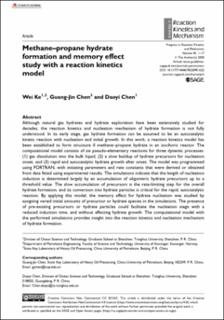| dc.contributor.author | Ke, Wei | |
| dc.contributor.author | Chen, Guang-Jin | |
| dc.contributor.author | Chen, Daoyi | |
| dc.date.accessioned | 2023-02-10T15:04:45Z | |
| dc.date.available | 2023-02-10T15:04:45Z | |
| dc.date.created | 2020-11-12T15:19:56Z | |
| dc.date.issued | 2020-05 | |
| dc.identifier.citation | Ke, W., Chen, G-J., & Chen, D. (2020) Methane–propane hydrate formation and memory effect study with a reaction kinetics model. Progress in reaction kinetics and mechanism, 45. | en_US |
| dc.identifier.issn | 1468-6783 | |
| dc.identifier.uri | https://hdl.handle.net/11250/3050089 | |
| dc.description.abstract | Although natural gas hydrates and hydrate exploration have been extensively studied for decades, the reaction kinetics and nucleation mechanism of hydrate formation is not fully understood. In its early stage, gas hydrate formation can be assumed to be an autocatalytic kinetic reaction with nucleation and initial growth. In this work, a reaction kinetics model has been established to form structure II methane–propane hydrate in an isochoric reactor. The computational model consists of six pseudo-elementary reactions for three dynamic processes: (1) gas dissolution into the bulk liquid, (2) a slow buildup of hydrate precursors for nucleation onset, and (3) rapid and autocatalytic hydrate growth after onset. The model was programmed using FORTRAN, with initiating parameters and rate constants that were derived or obtained from data fitted using experimental results. The simulations indicate that the length of nucleation induction is determined largely by an accumulation of oligomeric hydrate precursors up to a threshold value. The slow accumulation of precursors is the rate-limiting step for the overall hydrate formation, and its conversion into hydrate particles is critical for the rapid, autocatalytic reaction. By applying this model, the memory effect for hydrate nucleation was studied by assigning varied initial amounts of precursor or hydrate species in the simulations. The presence of pre-existing precursors or hydrate particles could facilitate the nucleation stage with a reduced induction time, and without affecting hydrate growth. The computational model with the performed simulations provides insight into the reaction kinetics and nucleation mechanism of hydrate formation. | en_US |
| dc.language.iso | eng | en_US |
| dc.publisher | SAGE Publishing | en_US |
| dc.rights | Navngivelse-Ikkekommersiell 4.0 Internasjonal | * |
| dc.rights.uri | http://creativecommons.org/licenses/by-nc/4.0/deed.no | * |
| dc.subject | petroleumsteknologi | en_US |
| dc.title | Methane–propane hydrate formation and memory effect study with a reaction kinetics model | en_US |
| dc.type | Peer reviewed | en_US |
| dc.type | Journal article | en_US |
| dc.description.version | publishedVersion | en_US |
| dc.rights.holder | © 2020 The Author(s). | en_US |
| dc.subject.nsi | VDP::Matematikk og Naturvitenskap: 400::Kjemi: 440 | en_US |
| dc.subject.nsi | VDP::Teknologi: 500::Berg‑ og petroleumsfag: 510::Petroleumsteknologi: 512 | en_US |
| dc.source.pagenumber | 17 | en_US |
| dc.source.volume | 45 | en_US |
| dc.source.journal | Progress in reaction kinetics and mechanism (Print) | en_US |
| dc.identifier.doi | 10.1177/1468678320901622 | |
| dc.identifier.cristin | 1847465 | |
| cristin.ispublished | true | |
| cristin.fulltext | original | |
| cristin.qualitycode | 1 | |

